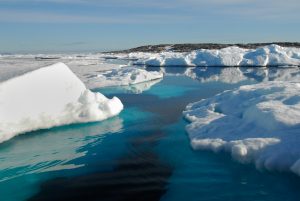
Researchers that are making efforts to clarify the data being collected on Antarctic sea ice by satellites using ground-based instruments are reporting that the extent of ice surrounding our southernmost continent has shrunk to a record low, nearly one million square kilometers (386,000 square miles) less than when record keeping began in 1986.
Working with the British-based Drivers and Effects of Fluctuations in sea Ice in the ANTarctic (DEFIANT), University of Calgary post-doctoral associate Vishnu Nandan and Robbie Mallett, a sea ice scientist with the University of Manitoba, are eight months into an expedition studying the ice out of Rothera Research Station on Antarctica’s Adelaide Island, using a ground-based radar system similar to those mounted on the European Space Agency’s CryoSat-2 satellite. The expedition’s efforts are to help improve the satellite’s ability to measure the depth of the ice, of which can be prone to inaccuracies after an appreciable amount of snow builds up on the surface, sometimes reaching a meter (three feet) in depth.
The team arrived expecting the ice extent to be low, given how warm it has been in the Antarctic this winter, but they weren’t expecting a record low. They were also faced with several days of rain—unusual for this time of the year—along with warm winds that were preventing the ocean ice from freezing properly.
“We actually came knowing we wouldn’t have a lot of sea ice, because it’s been really warm,” explained Nandan. “We came in where we had the lowest sea ice on record over the past many decades, so we didn’t have sea ice much and we had really thin ice in the winter.”
“Arctic sea ice has declined substantially—about 70 per cent over the past 30 to 40 years,” Nandan continued, referring to a previous expedition he participated in to the North Pole. “When compared to that, the Antarctic has been stable, but over the past few years, since about 2016, we have seen a dramatic decline in sea ice in many regions across the Antarctic.
“Right now it’s serious. It’s really bad. If you look at the overall area of the sea ice, the area is almost one million square kilometres less than the previous lowest which was in 1986.”
“Sea ice performs so many critical functions in Antarctica: it reflects sunlight and cools the planet, it keeps marine ecosystems healthy and productive, and its annual formation helps drive the global ocean circulation pattern, remarked principal investigator Julienne Stroeve, a Professor of Polar Observation & Modelling at the Centre for Polar Observation and Modelling, University College London. “So it’s been a shock to see the numbers sitting so far outside what we’ve seen over the last four decades.
“While the role of climate change in this record-breaking event has yet to be quantified, this year’s conditions are clearly cause for concern”.
Subscribers, to watch the subscriber version of the video, first log in then click on Dreamland Subscriber-Only Video Podcast link.
May God have mercy on his creation